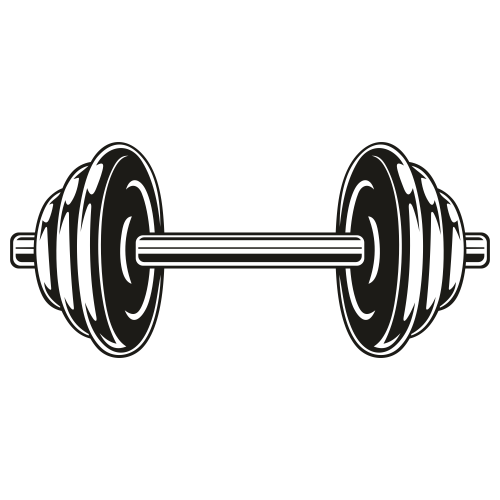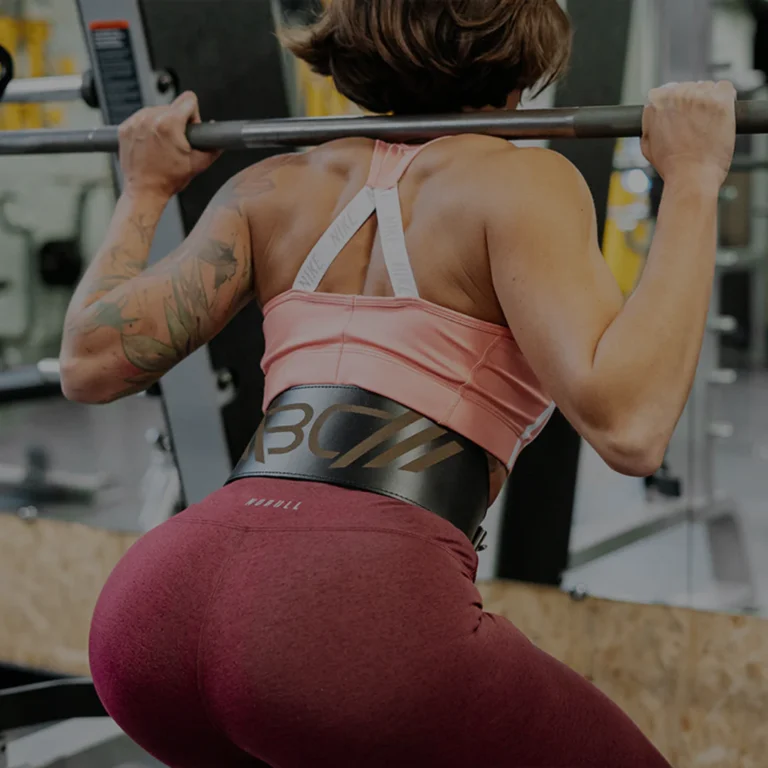Squatting with Chains: Benefits & How To Do It
Reviewed by Jacek Szymanowski
Squatting with chains refers to creating accommodating resistance where the load on the bar increases as the chains attached to each end of the bar rise off the floor.
Training with chains can shake up your current training program and challenge your body to do something new if you’re looking to introduce more diversity into your gym sessions.
So, is using chains with squats worth it?
Squatting with chains involves attaching chains to both barbell sides to create accommodating resistance where the load on the bar increases during the concentric phase. A squat with chains can be beneficial for improving acceleration, limiting the load at the bottom of squats, and strengthening the second part of ROM.
Using chains on the barbell during squats might not be the answer for everyone, especially if you’re still working on your regular squatting technique. This type of training may benefit experienced lifters looking to increase the intensity of their lifts by adding additional load.
Studies have shown chain squat training can have beneficial effects on lower limb explosive strength and maximum strength, both factors being advantageous for powerlifters and Olympic weightlifters.
Squatting with Chains
When lifters squat with chains, they set up a barbell as normal with plates, but also add a chain to each end of the barbell. In the bottom squat position, the majority of the chains will be on the floor, meaning the ground is taking the chain weight instead of the bar.
As you rise upwards from the squat to a standing position, the chains also raise, lifting off the floor with the bar, so the lifter takes the additional load of the chains.

This is known as accommodating resistance, as a chain squat utilizes chains to increase the weight with the ROM, so the lift is substantially harder in the second half of the range of motion. Using chains isn’t advisable for every lifter as it requires experience and correct squat form and technique.
Chains on barbell training is tough, so it’s best to wait until you’ve nailed your squat form and are already shifting a substantial weight with plates.
Additionally Powerlifters can see benefits from training with chains as they kind of mimic the effect of a squat suit.
Those taking part in equipped powerlifting competitions can use these types of supportive suits, so it makes sense for powerlifters training for equipped comps to include chained squats in some sessions. If you know how to set it up it will be overall a great addition to your strength workout.
3 Benefits Of Squatting With Chains
Introducing squat chains into your training program can have a wealth of benefits. However, it’s essential to still maintain a balanced program with various exercises and training methods to see the best results in your ability and performance.
✅ Can Improve Acceleration and Muscular Strength
One of the key answers to ‘why use chains when lifting is to improve acceleration with squats. The technique of squatting with chains is known as dynamic effort training (check conjugate method) which involves lifting a lighter weight (submaximal) at a faster speed (maximum force/velocity) thus improving acceleration over time.
A study looking at the effect of movement velocity during resistance training on dynamic muscular strength found resistance training performed at fast movement velocity had positive effects on muscular strength gains.
Therefore, training squats with chains may also be beneficial for increasing strength compared to moderate or slow resistance training, allowing the lifter to improve rate of force development.
✅ Limits Load At Bottom Of Squat
By limiting the load at the bottom of the squat, it allows for maximum acceleration to the top of the movement. Limiting the load also takes pressure off the knees when squatting as the weight is lightest in the low squat position where the knees are bent.
Squatting from the bottom upwards requires considerable stability, especially when the load increases the further you raise which is exactly what happens with a chain squat.

✅ Strengthens Second Part Of ROM
Squatting with chains allows the lifter to strengthen the second part of the ROM, as this is the phase of the squat that becomes the hardest due to the chains lifting off the ground and adding weight to the bar.
This can be beneficial for improving neurological involvement when producing a high volume of power and force when squat training with chains. If you’ve noticed your squat is weak during the concentric phase of the exercise, it may be beneficial to use chains to help work on your explosive power during the second part of ROM.
Subscribe!
Get useful tips, expert insights, and in-depth analysis of training programs & nutrition plans to get the most out of your performance.
3 Disadvantages Of Squatting With Chains
Alongside the benefits of using squat chains in some of your training sessions, there are also some potential drawbacks worth considering. Assessing the pros and cons of using chains during squats will allow you to better understand if it’s the right move to make with your training.
❌ Proper Understanding How To Program Load
Squatting with chains is an advanced technique, with beginners or inexperienced lifters being better off sticking to perfecting their conventional squat form and building that general strength first.
Having lifting experience and knowledge of strength programming is vital for success with chain squats, where the lifter can understand why they are performing the lift, how to program load, and the potential benefits of doing so.
Resistance training can be beneficial for increased lean mass and strength, but it needs to be carried out with consistent correct form to avoid injury and see the best results.
When setting up for chain squats, additional equipment needs to be introduced to complete the lift safely and effectively. Understanding how to use equipment for squatting with chains requires further knowledge and experience.
❌ Increased Difficulty and Complexity
If you’ve ever tried a chain squat, you’ll know how different it feels compared to regular squatting with a barbell and plates. Although there are potential benefits from using chains during squats, it’s vital to gain experience with conventional squats first before trying this technique out.

Chain squatting requires enhanced technique compared to regular squatting, making the method harder to perform and more difficult to achieve a proper set-up. There’s a risk of poor form and injury, especially when performing chain squats without a spotter.
The increased difficulty and complexity of the exercise means you ideally should have a spotter to keep you safe if anything goes wrong. There is also the potential for the weight to be uneven on each side if the chains aren’t used correctly.
A correct set-up is crucial for a successful set of squatting with chains, where the weight is equally balanced and the chains are securely attached. This equates to an advanced exercise only suitable for those with the expertise and knowledge of squatting with chains.
❌ Not Suitable For Beginners
Squatting with chains isn’t suitable for every lifter as it requires technique and form that’s spot on, as you don’t want to experience any unwanted shift in weight or excessive movement.
Beginners should focus on building the foundations of proper form and control with squats rather than advanced methods such as squatting with chains which have been designed for specific purposes.
Realistically, experienced lifters who have been training for a substantial amount of time and have progressed with their lifts can benefit from chain squats if they can lift 1.5 times their body weight.
This typically isn’t the case for beginners, so it’s best to stick to progressing with regular squats before attempting squats with bands or chains. Before attempting to squat with chains, ensure your form is correct and you can benefit from including this type of training in your program.

Pro Tip:
Equipment Required for Squatting with Chains
Unlike regular squatting which generally just requires the use of a barbell, plates, and collars, chain squatting requires a few additional pieces of equipment.
- Loader Straps/Leader Chain – for securely connecting the chains to the barbell
- Carabiner – to connect the loader strap or leader chain with the 5/8 inch chain
- Chain – ensure chain weight is approx 10-20% of 1RM for squats depending on experience and ability
If you don’t already have the equipment needed for squatting using chains, it can be worthwhile to invest in a chain kit such as this one we recommend from Rogue Fitness. The zinc electroplated chains are available in two different sizes, with the full kits also including carabiners with optional chain sheaths.

How To Properly Start Squatting with Chains?
There’s arguably more to consider when setting up for a set of squats with chains, as along with getting the bar ready with appropriate plates (if using), you also need to securely attach the chains on each end of the barbell.
Step 1: Prep The Bar
Prepare the barbell with the appropriate weight plates, and hook your loader strap or leader chain onto the ends of the barbell. Placing the straps near the end of the bar means the lift will feel more natural, with the weight will feel even on both sides.
Step 2: Attach Chains
Attach the chains to the loader straps using carabiners, ensuring there is enough chain on the ground to lift during the squat and that the chain is doubled over, not hanging in a straight line.
Step 3: Assess Chain Length
Ideally, the chain should almost fully deload into the ground during the bottom phase and nearly completely be lifted off the floor during the lockout stage where the bar is lifted. If your chains are in the correct position and there’s enough chain to lift and return to the ground as the bar is moved, you’re ready for your set.
Conclusion
The benefits of squatting such as strengthening the musculature of lower limbs have been proven time and time again, but squatting with chains can also have benefits.
These include improved acceleration and muscular strength, limiting the load at the bottom of a squat allowing focus on stability, and strengthening the second stage of the ROM.
Have you tried squats with chains? How did you find it and what results have you seen? Let us know in the comments below!
References:
- Dongting Jiang , Gang XU, “Effects of chains squat training with different chain load ratio on the explosive strength of young basketball players’ lower limbs”, Beijing Sport University, https://www.frontiersin.org/journals/physiology/articles/10.3389/fphys.2022.979367/full (Accessed April 12 2024).
- International Powerlifting Federation, Technical Rules Book 2024, https://www.powerlifting.sport/fileadmin/ipf/data/rules/technical-rules/english/IPF_Technical_Rules_Book_2024_24_Jan.pdf (Accessed April 12 2024).
- Timothy B. Davies, Kenny Kuang, Rhonda Orr, Mark Halaki, Daniel Hackett, “Effect of Movement Velocity During Resistance Training on Dynamic Muscular Strength: A Systematic Review and Meta-Analysis”, University of Sydney, Sports Med, https://paulogentil.com/pdf/Effect%20of%20Movement%20Velocity%20During%20Resistance%20Training%20on%20Dynamic%20Muscular%20Strength%20-%20A%20Systematic%20Review%20and%20Meta-Analysis.pdf (Accessed April 12 2024).
- Michael H Thomas, Steve P Burns, PhD, “Increasing Lean Mass and Strength: A Comparison of High Frequency Strength Training to Lower Frequency Strength Training”, National Center For Biotechnology Information, https://www.ncbi.nlm.nih.gov/pmc/articles/PMC4836564/ (Accessed April 14 2024).
- Luke Del Vecchio, Hays Daewoud, Shannon Green, “The health and performance benefits of the squat, deadlift, and bench press”, Department of Australian Combat & Exercise, Australia, https://medcraveonline.com/MOJYPT/MOJYPT-03-00042.pdf (Accessed April 12 2024).
- Photos are made by WBCM Media team.
Author: Sergii Putsov
PhD in Sport Science, Olympic weightlifting, Strength & Conditioning coach and fitness expert
Sergii Putsov is a professional weightlifter with over 20 years of experience and multiple national medals. He was a member of the National weightlifting team, competing in the 94 kg weight class. Sergii holds a master’s degree in Olympic & Professional Sport Training and a Ph.D. in Sport Science. After his athletic career, Sergii transitioned into coaching and is now responsible for designing training programs, writing blog articles, providing live commentary for international weightlifting competitions, and hosting sport and fitness seminars worldwide.
Reviewed by: Jacek Szymanowski
Performance architect, S&C movement specialist.
Jacek Szymanowski is a highly respected sports nutrition expert with a Master’s degree in Biotechnology. His innovative approach combines lifting and fighting strategies to help athletes optimize their performance. As a Strength and Conditioning Movement Specialist, he is dedicated to reducing injuries in athletes. His specialist training in Nutrition for Athletes equips him to provide expert advice on dietary habits and nutrition for peak performance.










